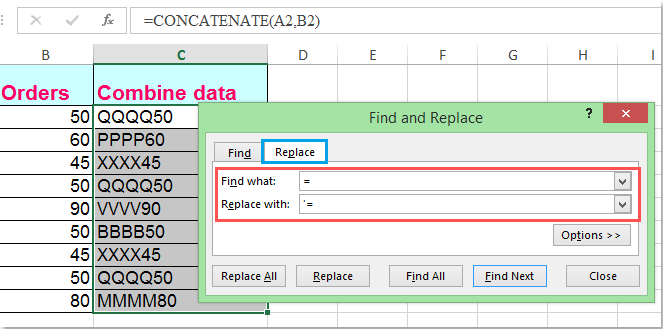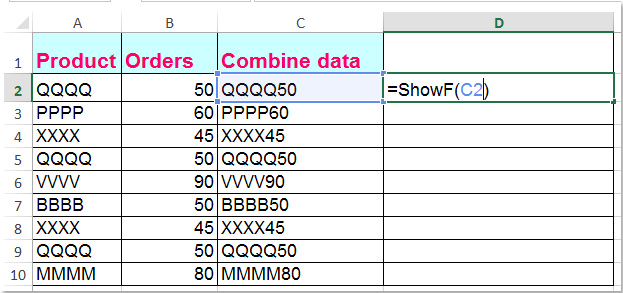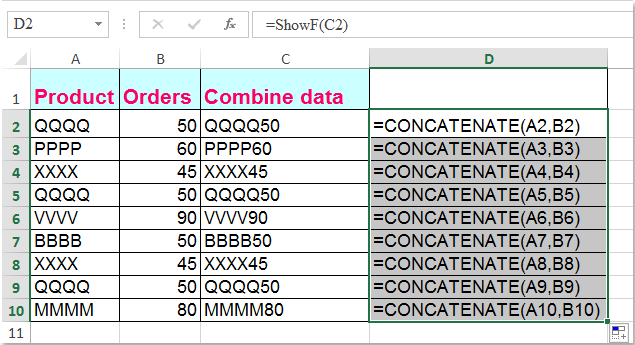Comment convertir une formule en chaîne de texte dans Excel ?
Normalement, Microsoft Excel affiche les résultats calculés lorsque vous entrez des formules dans les cellules. Cependant, parfois, vous pourriez avoir besoin d'afficher uniquement la formule dans la cellule, comme =CONCATENATE("000", " - 2"), comment allez-vous gérer cela ? Il existe plusieurs façons de résoudre ce problème :
Convertir une formule en chaîne de texte avec la fonctionnalité Rechercher et Remplacer
Convertir une formule en chaîne de texte ou vice versa en un seul clic
Convertir une formule en chaîne de texte avec une fonction définie par l'utilisateur
Convertir une formule en chaîne de texte avec la fonctionnalité Rechercher et Remplacer
Supposons que vous ayez une plage de formules dans la colonne C, et que vous deviez afficher la colonne avec les formules originales mais pas leurs résultats calculés, comme le montrent les captures d'écran suivantes :
 |  |
Pour résoudre cette tâche, la fonctionnalité Rechercher et Remplacer peut vous aider, veuillez procéder comme suit :
1. Sélectionnez les cellules contenant les résultats calculés que vous souhaitez convertir en chaînes de texte.
2. Appuyez ensuite simultanément sur les touches Ctrl + H pour ouvrir la boîte de dialogue Rechercher et Remplacer. Dans la boîte de dialogue, sous l'onglet Remplacer, saisissez le signe égal = dans la zone de texte Rechercher quoi, et saisissez '= dans la zone de texte Remplacer par, voir capture d'écran :

3. Cliquez ensuite sur le bouton Remplacer tout, vous pouvez voir que tous les résultats calculés sont remplacés par les chaînes de texte des formules originales, voir capture d'écran :

Convertir une formule en chaîne de texte ou vice versa en un seul clic
Si vous avez Kutools pour Excel, avec sa fonction Convertir les formules en texte, vous pouvez transformer plusieurs formules en chaînes de texte en un seul clic.
Après avoir installé Kutools pour Excel, veuillez procéder comme suit :
1. Sélectionnez les formules que vous souhaitez convertir.
2. Cliquez sur Kutools > Texte > Convertir les formules en texte, et vos formules sélectionnées sont immédiatement converties en chaînes de texte, voir capture d'écran :

Astuce : Si vous souhaitez reconvertir les chaînes de texte des formules en résultats calculés, appliquez simplement l'utilitaire Convertir le texte en formule comme le montre la capture d'écran suivante :

Téléchargez et essayez gratuitement Kutools pour Excel maintenant !
Convertir une formule en chaîne de texte avec une fonction définie par l'utilisateur
Le code VBA suivant peut également vous aider à gérer cela facilement.
1. Maintenez les touches Alt + F11 enfoncées dans Excel, ce qui ouvre la fenêtre Microsoft Visual Basic pour Applications.
2. Cliquez sur Insérer > Module, puis collez la macro suivante dans la fenêtre Module.
Function ShowF(Rng As Range)
ShowF = Rng.Formula
End Function
3. Dans une cellule vide, comme la Cellule D2, entrez une formule =ShowF(C2).

4. Cliquez ensuite sur la Cellule D2, et faites glisser la poignée de recopie ![]() vers la plage dont vous avez besoin.
vers la plage dont vous avez besoin.

Meilleurs outils de productivité pour Office
Améliorez vos compétences Excel avec Kutools pour Excel, et découvrez une efficacité incomparable. Kutools pour Excel propose plus de300 fonctionnalités avancées pour booster votre productivité et gagner du temps. Cliquez ici pour obtenir la fonctionnalité dont vous avez le plus besoin...
Office Tab apporte l’interface par onglets à Office, simplifiant considérablement votre travail.
- Activez la modification et la lecture par onglets dans Word, Excel, PowerPoint, Publisher, Access, Visio et Project.
- Ouvrez et créez plusieurs documents dans de nouveaux onglets de la même fenêtre, plutôt que dans de nouvelles fenêtres.
- Augmente votre productivité de50 % et réduit des centaines de clics de souris chaque jour !
Tous les modules complémentaires Kutools. Une seule installation
La suite Kutools for Office regroupe les modules complémentaires pour Excel, Word, Outlook & PowerPoint ainsi qu’Office Tab Pro, idéal pour les équipes travaillant sur plusieurs applications Office.
- Suite tout-en-un — modules complémentaires Excel, Word, Outlook & PowerPoint + Office Tab Pro
- Un installateur, une licence — installation en quelques minutes (compatible MSI)
- Une synergie optimale — productivité accélérée sur l’ensemble des applications Office
- Essai complet30 jours — sans inscription, ni carte bancaire
- Meilleure valeur — économisez par rapport à l’achat d’add-ins individuels